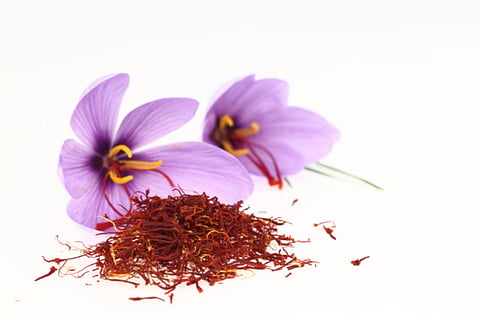The goodness of saffron
The aromatic spice not only lends a rich flavour to food but also helps alleviate problems such as heart disease, depression and insomnia

No spice is more special than saffron. Its scent is haunting, its unmistakable flavour earthy yet aristocratic and subtle. It straddles sweet and savoury effortlessly, and it bestows a striking golden hue on every dish it graces. A few strands of saffron will transform a long list of dishes, adding an X factor to everything from risottos and milk puddings to rich curries and fish stews.
Avoid the powdered sort, it’s liable to fraud and adulteration and generally disappoints. Get the maximum from your saffron stigmas (strands) by warming them very gently for a few seconds, pounding them lightly and then infusing them in liquid for a minute or two to help release their glorious colour and aroma.
Why is saffron good for me?
It has long been used in traditional medicine around the world, and modern scientific study suggests that saffron could also have a role to play in fighting disease. Research suggests that the carotenoid compounds responsible for saffron’s striking colour (safranal, crocetin, crocin) could play a part in inhibiting the growth of tumours. The active constituents in saffron could help alleviate gastric problems, heart disease, insulin resistance, depression, premenstrual syndrome, insomnia and anxiety. Eating saffron also appears to help vision by retarding the degeneration of the retina that occurs with age.
Where to buy and what to pay?
Saffron is infamously expensive, but as just a pinch of good saffron will enliven a dish, it won’t break the bank. Cheap saffron is a bad deal. Guide price: £4‑£4.50 (Dh23-Dh25) per 0.5g.
GOOSEBERRIES IN HONEY SAFFRON CUSTARD
This recipe works well with many fruits, so it’s a year-round recipe. Some fruits, such as the gooseberries, will need to be cooked a little first but others such as currants can go straight in. Balance the sugar accordingly.
Serves: 4
INGREDIENTS
200g gooseberries, topped and tailed
40g caster sugar
4 egg yolks
400ml single cream
21/2 tsp honey
1/4 tsp saffron strands
Preheat the oven to 160C. Put the gooseberries into a bowl, add the sugar and 2 tbs water, then mix, so the sugar is coating the fruit. Divide the gooseberries between four ramekins and stand them in a roasting tin. Cover with foil and place in the oven for about 7-10 minutes until the fruit just softens a little. Turn the oven down to 140C.
In the meantime, whisk the egg yolks, cream, honey and saffron. Place the bowl over a pan of simmering water, making sure the base of the bowl isn’t in contact with the water. Stir gently for about 10 minutes, until the mixture coats the back of a spoon.
Strain the custard over the gooseberries. Fill the roasting tin with warm water to about halfway up the ramekins. Bake for about 45 minutes to an hour until just set.
Leave to cool for a few minutes before removing the ramekins from the tin and placing on a rack to cool.
— Rosie Sykes is head chef of Fitzbillies and co-author of The Kitchen Revolution
— Guardian News & Media Ltd
Sign up for the Daily Briefing
Get the latest news and updates straight to your inbox
